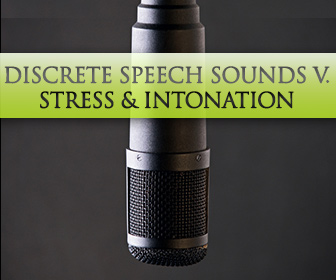Which is More Important? Discrete Speech Sounds v. Stress and Intonation


I shook his hand, at the same time wondering about his name choice—it’s not uncommon for ESL students to Westernize their names, but Asher? Why this name of a relatively obscure Jewish prophet? The student was writing his name out for me at the same time, on his student profile, and I felt silly when I saw it was “Arthur,” a much more reasonable choice for an ESL student’s Americanized name. And I was glad that he was in the ESL pronunciation class as he had chosen the Western name he could not pronounce—well, there was a lot of work to be done, clearly. And I knew that the pronunciation of the “th” sound would be featured early. However, most ESL students will not so obligingly provide an informal diagnostic like this in the first moments of class. So this leaves the ESL pronunciation teacher wondering where to begin. The answer is on face value easy: begin with the students and their needs. How then do you know student needs? A good informal ESL pronunciation assessment will lead you to student needs and the course curriculum.

“Suprasegmentals”: the More “Global” Issues of Stress and Intonation. These issues of stress and intonation are not the most important pronunciation issue, necessarily—pronunciation of individual speech sounds also matter—but these concerns affect pronunciation across words, phrases, and sentences.
Often words are unintelligible if the stress is on the wrong syllable, so it is important to learn some general principles of word stress: many “everyday” or “conversational” nouns receive their stress on the first syllable, for example, while related verbs do on the second syllable (e.g., the “effect” and to “affect”, related noun and verb pronounced the same except for the stress). Also, a big difference in meaning between two different words is often in the word stress (“Give the teacher a message” versus “Give the teacher a massage”). Assessing student understanding of word stress to find areas to focus on for instruction is therefore important.
A good understanding of spoken English requires control of the stress of declarative sentences (i.e., sentences that are not questions). A sentence in spoken English has a definite pattern of alternating stressed and unstressed syllables, with the major content words, the words that carry meaning, receiving the most stress, while “grammar words” without much individual meaning (e.g., “the”, “a”, “and”) are unstressed and reduced.
Because students typically have a lot of questions, they should also learn correct intonation patterns for English questions.
Liaison involves connecting words in a predictable pattern: e.g., “Do you want coffee?” comes out in conversation more like “Duhyuhwan coffee?” It is a mark of a native-speaker to use liaison effortlessly. However, with practice, ESL students can achieve the much the same kind of control.

In addition to the suprasegmental elements of stress and intonation, individual speech sounds, like the “th” sound in English, are important to being understood. Common problem areas for ESL students should be focused on. Many students will have trouble with the use of the “schwa, “the “uh” sound, in unstressed syllables: e.g., “American” is really pronounced something like “uhMERuhcun”, with only the second vowel in the stressed syllable a full vowel; the rest of the vowels in unstressed syllables are reduced and pronounced as schwas. Because most unstressed vowels are pronounced as shwa, it is an important individual speech sound to learn. Other speech sounds for probable focus are the “ee/eh” distinction as well as the “t/th” distinction.

This is good for initial assessment, getting a taped speech sample of each student in such tasks as reading aloud from a book and having a short dialogue with the teacher, as well as giving an impromptu speech on an everyday topic such as “My First Day at College.” Such an assessment will provide a permanent record of student performance in such areas of stress of content words, reduction of grammar words, question intonation, concerns with discrete speech sounds, and so forth. The teacher then can use these assessments not only to track individual student progress over the course of the semester, if he tapes students periodically, but it also gives a starting point to the term if many students show similar pronunciation concerns.
This is good for ongoing assessment, to see if students are learning the curriculum. Just walking around and noting student performance in simple dialogues with each other can yield a wealth of information of how much more focus needs to be given to stressing content words and reducing grammar words, or the “s/sh” distinction, for example.
Another good way to assess student pronunciation is the interview. Interviews should be individual and ongoing, perhaps at entry, midterm, and exit, during which time the instructor can ask informal questions about students’ lives, educational progress, work experiences, and so forth. Interviews are not only a good way to note student progress but also to check in when each student and get to know him or her.
Frequent small quizzes are often more valuable that the one big midterm or final: they keep students and teachers updated about progress and what needs to be reviewed and what has been mastered. In addition, frequent small tests are not as anxiety-provoking to students as they know their grade is not dependent on a single quiz, allowing them to focus their energy on learning rather than on worrying about the test.
This is not to say, however, that occasional big tests — the midterm, the unit final — are without value. Big tests carry psychological importance: passing the midterm is a kind of milestone, signaling some mastery to the student and teacher. A well-constructed midterm or other large test that covers a number of skills learned in class also reveals a more complete picture of an individual student, his strengths and weaknesses, as well as general trends in the class and what has been learned well and what needs to be revisited.
Teaching ESL pronunciation is not easy; even more difficult may be assessing pronunciation. However, by using multiple methods of assessment, and assessing frequently throughout the term, the instructor can get a clear picture of student instructional needs and progress.